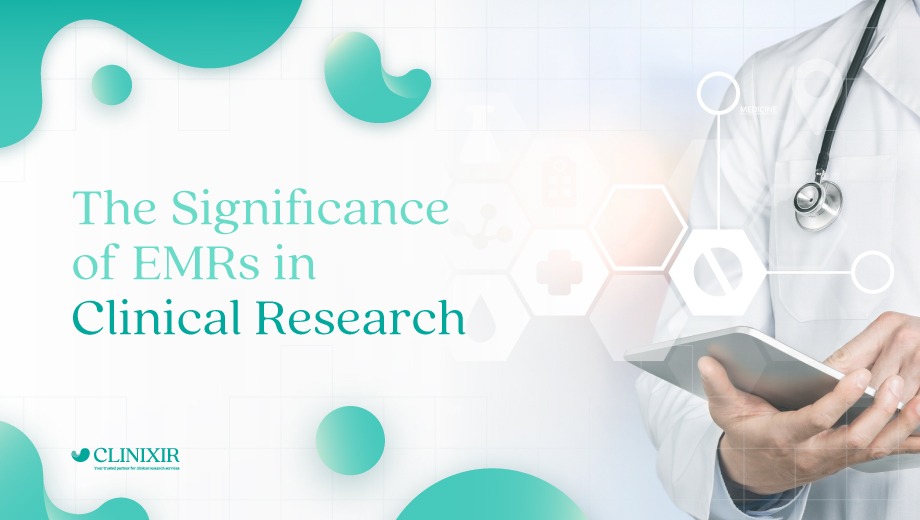Clinical research is entering a new era where electronic medical records (EMRs) play an increasingly significant and novel supporting role. Today, better systems and new research infrastructure facilitate the use of EMRs for clinical research and trials. EMRs are convenient alternatives to traditional paper-based medical records, offering clinical researchers and physicians instantaneous access to well-organized patient data that can be effectively utilized for research purposes.
What is an electronic medical record?
Electronic medical records (EMRs) are digital representations of a patient’s paper chart. They constitute patient-centered, real-time records that securely and promptly make information accessible to authorized users within an organization. These records contain information about patients’ medical histories, diagnoses, and treatments by specific doctors, nurse practitioners, specialists, dentists, surgeons, and clinics. Although EMRs do contain patients’ medical and treatment histories, they are designed to go beyond the typical clinical data gathered in a clinical provider’s office and can include a wider perspective of patient care.
As crucial components of health IT, EMRs can be used to:
- Track a patient’s medical history, diagnoses, prescriptions, treatment schedule, immunization records, dates of allergy shots, radiology images, and laboratory and test results.
- Give clinical researchers and professionals access to evidence-based instruments so they can decide how to develop medical interventions and treat patients.
- Automate and streamline researcher and provider workflow.
One of the key functions of an EMR is the ability of authorized providers to use it for collating, converting, and managing multiple records into a single, interoperable digital format that can be shared with other providers across multiple healthcare organizations. This form of data is known as an electronic health record (EHR).
EHRs are standardized records of a person’s healthcare data that adhere to suggested interoperability standards and are developed, maintained, and used by authorized clinicians and staff from various healthcare organizations. An EHR represents the concept of an individual’s longitudinal health record. These records are shared with clinics at work and in schools, as well as laboratories, specialists, imaging centers, pharmacies, and emergency rooms. As a result, the aforementioned locations are most likely to have access to standardized records from every clinician involved in a patient’s care.
The advantages of integrating EMRs into clinical research
Clinical research and practice enhancement: The use of electronic medical records improves patient care, physician performance, and research capabilities. It must be noted that in the ever-changing landscape of medical knowledge, medical professionals need to keep up with a range of information. Physicians can’t possibly be all-knowing, but digital data systems can keep them better informed than virtually any other method. Electronic medical records are also used to facilitate institutional collaboration and improve data access, effectively improving the way clinical researchers and physicians manage their practices.
Cost and time efficiency: With access to a sizable database of patient-centered records, clinical researchers can easily identify patient groups for trial enrollment, and conduct preliminary studies before the start of clinical trials. This ability greatly reduces the likelihood of error, the overall expenditure for clinical research, and the amount of time spent on manual reporting and diagnostics.
Better data quality and patient safety: EMR systems are particularly advantageous for clinical researchers. They conveniently gather, compile, and present information in an organized and systematic way that is not possible using paper-based files. Researchers can monitor any changes that have occurred over time with the help of this data, which is displayed as graphs and pie charts and includes values for blood pressure, weight, and cholesterol levels. Additionally, such data lets researchers manage screening goals and chronic diseases more effectively, raising the standard of care given to patients. Lastly, EMRs can alert investigators to outdated procedures and prevention strategies during clinical trials, helping them apply new ones. This improvement further bolsters the level of patient safety within each clinical trial, which is imperative to the success of the clinical trial as a whole.
The future of clinical research using EMRs/EHRs
In the coming years, data quality and operational efficiency will be the cornerstones of clinical research — and the integration of EMRs is necessary in order to simultaneously accomplish both objectives. On top of this, clinical research organizations can use EMRs to help their sponsors consistently achieve their business goals. For example, EMRs help researchers avoid operational issues, letting any conflicts within prescription and health data be identified right away.
Clinixir provides industry-leading services to help your business create cutting-edge treatments. Our advanced research methods, affiliation with Thailand’s top medical institutions, access to the country’s largest set of medical records, integration of EMRs, RTSMs, and EDCs, extensive regulatory knowledge, and state-of-the-art technologies can help your organization put reliable drugs and treatment methods on the market, maximizing your commercial output and ultimately providing a better quality of life for the general public.
To learn more, contact us today.



